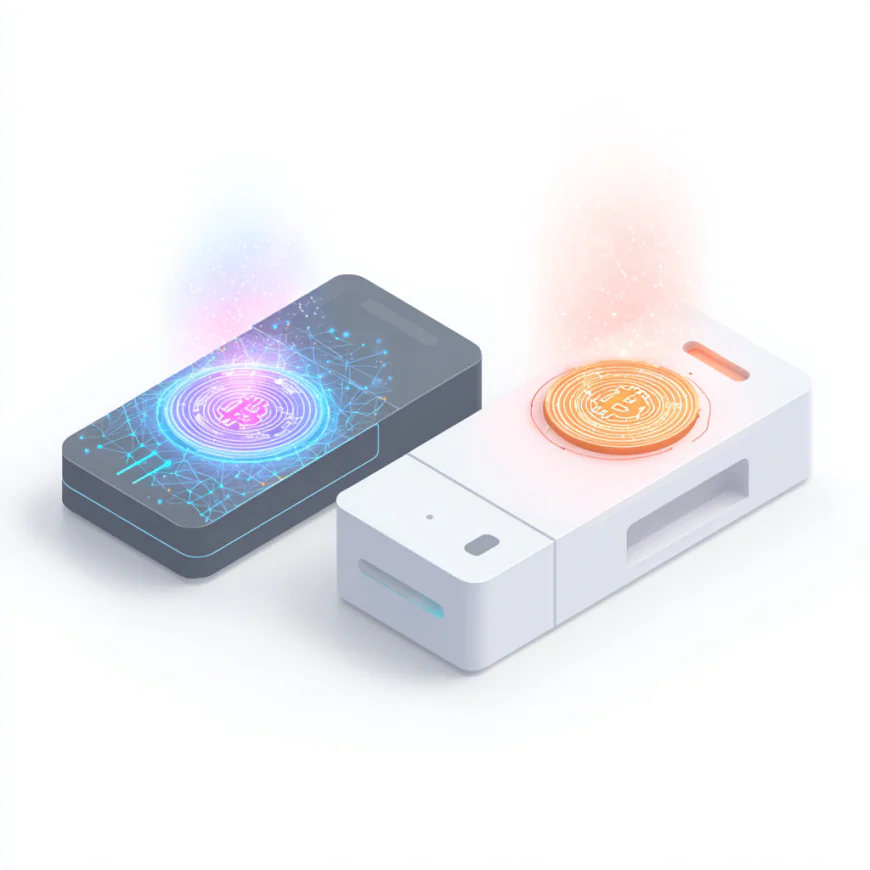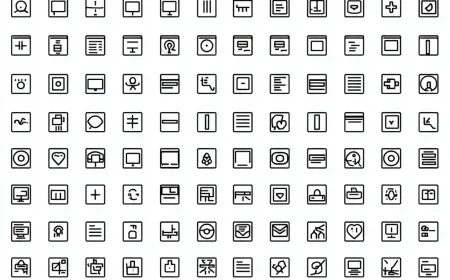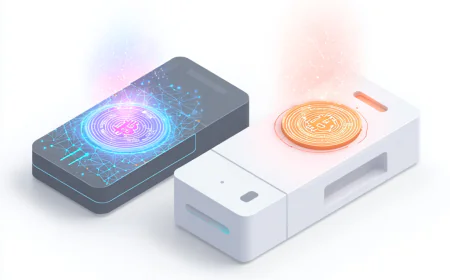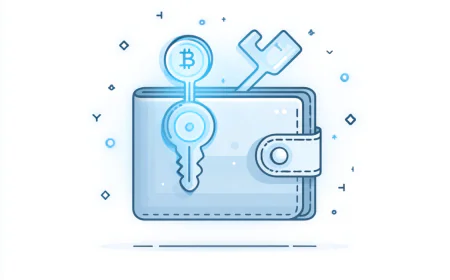Hot vs Cold Wallets — MetaMask vs Ledger/Trezor
A complete guide to hot vs cold wallets. Learn the key differences between MetaMask (hot wallet) and Ledger/Trezor (cold wallets), with pros, cons, security tips, and best practices for storing your crypto safely in 2025 and beyond.

Hot vs Cold Wallets — MetaMask vs Ledger/Trezor
In the world of cryptocurrency, wallets are not just a convenience — they are the very foundation of digital asset ownership. Whether you are sending Bitcoin, buying NFTs, or investing in DeFi protocols, you need a wallet to interact with the blockchain. But not all wallets are created equal. Broadly, they fall into two categories: hot wallets and cold wallets. In this blog, we will dive deep into the differences, trace the history of wallets, and compare the most popular examples — MetaMask (hot wallet) vs Ledger and Trezor (cold wallets). The goal is to provide a comprehensive, beginner-friendly, yet technically detailed guide that can serve both newcomers and experienced crypto users.
Introduction
When someone first encounters cryptocurrency, one of the first questions they ask is: “Where do I keep my Bitcoin or Ethereum?” Unlike traditional bank accounts, cryptocurrencies are not held by banks or centralized entities. Instead, they exist on decentralized networks called blockchains. However, you cannot simply “hold” Bitcoin in your hand. You need a tool that allows you to prove ownership and interact with the blockchain — that tool is called a crypto wallet.
A crypto wallet is a piece of software or hardware that stores your private keys. These keys are the cryptographic credentials that allow you to access, send, and control your digital assets. Lose the keys, and you lose access to your funds. Share them with the wrong party, and your coins are gone forever. This is why choosing the right wallet is the single most important security decision any crypto holder will ever make.
Why Are Crypto Wallets Essential?
Many beginners mistakenly think that leaving funds on an exchange like Binance or Coinbase is enough. But this comes with a catch: you do not really own the crypto in that case. The exchange holds the private keys on your behalf. This arrangement is called a custodial wallet. If the exchange shuts down, gets hacked, or freezes your account, you may lose your coins.
This gave rise to one of the most famous sayings in the crypto industry: “Not your keys, not your coins.” In other words, unless you personally hold the private keys, you are not in full control of your digital wealth. True ownership comes only with wallets where you manage the keys yourself — non-custodial wallets.
The Core Idea of Hot vs Cold Wallets
The classification of wallets into hot and cold stems from one simple factor: connection to the internet.
- Hot Wallets are always connected to the internet. Examples include MetaMask, Trust Wallet, and Coinbase Wallet. They are convenient, fast, and ideal for daily use. However, they are more vulnerable to hacks, phishing, and malware.
- Cold Wallets are offline by design. Examples include hardware wallets like Ledger and Trezor, paper wallets, or even air-gapped computers. They are less convenient but far more secure, making them the go-to solution for long-term storage of large amounts of crypto.
The Historical Evolution of Wallets
The very first Bitcoin wallets were simply desktop software clients — the original Bitcoin Core wallet launched in 2009. These were hot wallets because they operated on internet-connected computers. As the industry grew and billions of dollars started flowing into digital assets, hackers increasingly targeted exchanges and hot wallets. One of the turning points came in 2014, when the Mt. Gox exchange lost 850,000 BTC to hackers — at the time, this was worth nearly half a billion dollars.
This crisis led to innovation. In 2013, SatoshiLabs released Trezor, the first hardware wallet designed for everyday users. Ledger followed in 2014 with a version that incorporated secure chips. These products created the cold wallet market and introduced a new paradigm for crypto security.
Why Is This Topic Critically Important Today?
The 2020s saw explosive growth in cryptocurrencies, NFTs, and DeFi platforms. With billions of dollars moving across decentralized networks, security became a top concern. In 2022 and 2023 alone, hackers stole more than $3 billion worth of crypto, with the majority of the losses occurring through compromised hot wallets and phishing attacks.
In this environment, every crypto user — whether holding $100 or $1 million — must make a strategic decision: what portion of funds to keep in hot wallets for accessibility, and what portion to secure in cold wallets for long-term safety. This blog is here to guide you through those choices.
Part I: Fundamentals of Crypto Wallets
What Is a Crypto Wallet?
A crypto wallet does not actually store your coins. All cryptocurrencies exist on the blockchain itself, which is a distributed public ledger. What the wallet stores are the keys that give you the right to spend or transfer those coins.
- Private Key: A secret cryptographic string that acts as your proof of ownership. Anyone with access to it can spend your coins.
- Public Key: Derived from the private key, this is shared openly as your receiving address.
- Seed Phrase: A 12- to 24-word human-readable backup of your private keys. If you lose access to your device, the seed phrase can restore your wallet. Lose the seed, and your funds are gone permanently.
Custodial vs Non-Custodial Wallets
Wallets also differ in who controls the keys.
- Custodial Wallets: The keys are held by a third party, usually an exchange. Pros: convenience, customer support, password resets. Cons: you don’t actually control your funds.
- Non-Custodial Wallets: The keys are entirely in your control. Pros: full sovereignty, censorship-resistant. Cons: total responsibility for security and backups.
How Blockchain Transactions Work
When you send Bitcoin, you are not “moving coins” in the traditional sense. Instead, you are creating a digital signature with your private key that authorizes the network to update its ledger and assign ownership to the recipient’s address. Every node in the network verifies that the signature matches the public key and that you actually have the funds. This cryptographic system is what makes blockchain secure and decentralized — but it also means losing your key equals losing your money forever.
Historical Case Studies
Several infamous incidents demonstrate the importance of wallets:
- Mt. Gox (2014): Hackers stole 850,000 BTC because too much was stored in hot wallets on an exchange.
- Bitfinex (2016): One of the largest hacks in history — 120,000 BTC stolen. Again, the vulnerability came from online wallet systems.
- QuadrigaCX (2019): The exchange’s founder died unexpectedly, taking with him the only keys to cold wallets that held $190 million worth of customer funds. Users lost everything.
These events permanently shaped crypto security practices and demonstrated why cold wallets became non-negotiable for serious investors.
Why Cold Wallets Became a Necessity
For small amounts of crypto used daily, hot wallets are practical. But for larger investments or long-term holdings, cold wallets are essential. By keeping private keys completely offline, cold wallets dramatically reduce the attack surface. This is why most professional investors, institutions, and even crypto funds adopt a dual-wallet strategy: hot wallets for liquidity, cold wallets for storage.
Part II: Hot Wallets in Detail — MetaMask
What Exactly Is a Hot Wallet?
A hot wallet is any crypto wallet connected to the internet. This includes browser extensions, mobile apps, and exchange accounts. Because they are always online, hot wallets enable instant transactions — but that same connectivity exposes them to potential cyber threats. Hot wallets are ideal for day-to-day use: buying NFTs, trading tokens on decentralized exchanges, or interacting with DeFi applications. However, they are not recommended for long-term storage of large amounts of cryptocurrency.
Introducing MetaMask
MetaMask is the most popular hot wallet in the world, created in 2016 by ConsenSys. Originally launched as a simple browser extension for Chrome and Firefox, MetaMask allowed users to interact with the Ethereum blockchain without running a full Ethereum node. Over the years, it has grown into a comprehensive wallet solution, supporting multiple networks, including Ethereum, Polygon, BNB Smart Chain, Avalanche, Arbitrum, Optimism, and more.
As of 2025, MetaMask boasts over 30 million monthly active users, making it the gateway to Web3 for most people. It supports both browser extensions and mobile apps, and is often the first wallet beginners encounter when exploring decentralized applications (dApps).
Key Features of MetaMask
- Browser Extension: Available on Chrome, Firefox, Brave, and Edge.
- Mobile App: iOS and Android apps with biometric login.
- Multi-Network Support: Ethereum and all EVM-compatible blockchains.
- dApp Integration: Works seamlessly with platforms like Uniswap, OpenSea, and Aave.
- Token Management: Supports ERC-20, ERC-721 (NFTs), and other token standards.
- Hardware Wallet Compatibility: Can integrate with Ledger or Trezor for extra security.
Advantages of Using MetaMask
- Ease of Use: Simple setup process — just install, create a wallet, and you’re ready to transact.
- Free to Use: No upfront cost, only transaction fees (gas fees).
- Accessibility: Works directly from your browser or smartphone.
- dApp Gateway: Most DeFi and NFT platforms recognize MetaMask as the default wallet.
- Backup with Seed Phrase: Users can restore wallets anytime using their 12- or 24-word seed phrase.
Disadvantages and Risks of MetaMask
- Security Risks: Private keys are stored locally on your device. If your computer is infected with malware, hackers can steal your funds.
- Phishing Attacks: Fake websites often trick users into giving away their seed phrase.
- No Recovery Service: If you lose your seed phrase, nobody — not even MetaMask — can recover your funds.
- Gas Fees: On networks like Ethereum, fees can become expensive during peak times.
⚠️ Security Tip: Always double-check URLs before connecting MetaMask. Scammers frequently create fake sites mimicking Uniswap, OpenSea, or even MetaMask itself. Bookmark the official links and never share your seed phrase.
Setting Up MetaMask: Step-by-Step
- Download the official extension from MetaMask.io or the official app store.
- Create a new wallet. You’ll be shown a 12-word seed phrase — write it down on paper and store it securely. Never keep it in plain text on your computer or cloud storage.
- Set a strong password for local access.
- Add custom networks (like Polygon or BNB Smart Chain) by entering RPC details.
- Start using MetaMask with your favorite dApps.
MetaMask and DeFi
One of the strongest aspects of MetaMask is its seamless integration with decentralized finance (DeFi). Whether you are swapping tokens on Uniswap, lending assets on Aave, or yield farming across multiple chains, MetaMask acts as your digital passport. When you visit a dApp, it typically asks you to “Connect Wallet.” With one click, MetaMask links your account and allows you to sign transactions directly.
MetaMask and NFTs
NFT marketplaces like OpenSea and Rarible rely heavily on MetaMask. With a single click, you can list NFTs for sale, bid on auctions, or mint new tokens. This convenience is part of what made NFTs go mainstream in 2021–2022, as MetaMask became the universal standard for crypto wallets in the digital art world.
Security Threats and Real-World Cases
Unfortunately, MetaMask’s popularity also makes it a prime target for cybercriminals. According to Chainalysis, over $500 million was lost in 2023 alone due to phishing scams targeting MetaMask users. Most cases involved users being tricked into revealing their seed phrase or signing malicious transactions that gave hackers control over their funds.
Example: In 2022, a fake Google ad campaign redirected thousands of users to a phishing site that looked identical to MetaMask’s login page. Many entered their seed phrases, only to see their wallets drained within minutes. This highlighted the importance of verifying URLs and never typing your recovery phrase anywhere online.
MetaMask vs Other Hot Wallets
| Feature | MetaMask | Trust Wallet | Coinbase Wallet |
|---|---|---|---|
| Supported Networks | Ethereum + EVM chains | Multiple blockchains (BTC, ETH, BNB, etc.) | Ethereum + EVM chains |
| dApp Integration | Excellent (industry standard) | Good, but less supported than MetaMask | Strong, especially with Coinbase ecosystem |
| Hardware Wallet Support | Yes (Ledger & Trezor) | No direct integration | No direct integration |
| User Friendliness | Easy for dApps, some learning curve | Very beginner-friendly | Beginner-friendly, but centralized feel |
When to Use MetaMask
MetaMask is best suited for active crypto users who regularly interact with dApps, DeFi platforms, or NFT marketplaces. It’s also useful for quick transfers and small-to-medium amounts of crypto. However, it should not be used as the sole storage solution for large holdings. For serious security, users should pair MetaMask with a hardware wallet like Ledger — MetaMask provides the interface, while the hardware wallet keeps private keys safe offline.
✅ Best Practice: Think of MetaMask as your checking account — convenient but not ideal for life savings. For long-term wealth preservation, always move excess funds to a cold wallet.
Part III: Cold Wallets in Detail — Ledger & Trezor
What Is a Cold Wallet?
A cold wallet is any wallet that stores private keys completely offline, away from the internet. This offline design makes them significantly more secure than hot wallets, which are constantly exposed to potential online threats. Cold wallets come in various forms: paper wallets, air-gapped computers, and most importantly, hardware wallets like Ledger and Trezor.
Think of cold wallets as the equivalent of a safe deposit box at a bank. While you may not use it every day, it is the safest place to store your most valuable assets. For serious investors and institutions, cold storage is considered a non-negotiable requirement.
How Hardware Wallets Work
Hardware wallets are physical devices, usually resembling USB sticks, that generate and store private keys offline. When you initiate a transaction, the wallet signs it internally and only transmits the signed transaction back to your computer or phone. At no point do the private keys leave the device. This means even if your computer is compromised by malware, hackers cannot steal your private keys.
This principle is known as “air-gapped signing”. The wallet is isolated from the internet, and the cryptographic operations occur in a secure environment inside the device.
Trezor: The Pioneer of Hardware Wallets
Trezor was the world’s first hardware wallet, launched in 2013 by SatoshiLabs, a Czech-based company. The name "Trezor" means “safe” in Czech, which perfectly reflects its purpose. Trezor devices are open-source, which means their firmware can be publicly reviewed for transparency and security.
- Trezor One: The original model, supporting Bitcoin and many altcoins.
- Trezor Model T: The premium version, with a color touchscreen and broader coin support.
Trezor’s open-source philosophy made it a favorite among crypto purists who valued transparency and decentralization. By 2025, Trezor remains one of the most trusted hardware wallet brands globally.
Ledger: Secure Element Technology
Ledger, founded in 2014 in France, took a different approach. Instead of fully open-source, Ledger uses a proprietary secure element (SE) chip — the same kind of hardware used in passports and credit cards. This chip provides an extra layer of protection against physical attacks.
- Ledger Nano S: Affordable entry-level model.
- Ledger Nano X: Bluetooth-enabled, with mobile app integration.
- Ledger Stax: A premium model with a curved E-Ink display, designed by Tony Fadell (co-creator of the iPod).
Ledger devices are widely used not only by individuals but also by institutions, thanks to their robust security certifications (Common Criteria EAL5+).
Advantages of Cold Wallets
- Maximum Security: Keys never touch the internet, minimizing the risk of remote hacks.
- Offline Backup: Seed phrases can be stored physically, e.g., on metal plates, resistant to fire or water damage.
- Multi-Asset Support: Ledger supports 5,000+ coins and tokens, Trezor supports hundreds.
- Integration: Can be used in combination with MetaMask for secure DeFi/NFT interactions.
Disadvantages of Cold Wallets
- Cost: Unlike free software wallets, hardware wallets cost between $50–$300.
- Convenience: Requires physical access to the device for every transaction.
- Loss or Theft: If the device and the seed phrase are lost, funds are irrecoverable.
🔒 Best Practice: Treat your hardware wallet like a vault. Do not carry it everywhere, and never store your recovery seed phrase digitally.
Security Incidents and Lessons Learned
No system is perfect, and both Ledger and Trezor have faced challenges.
- Ledger Data Breach (2020): Hackers breached Ledger’s customer database, leaking personal information (emails, phone numbers, addresses) of over 250,000 users. However, no private keys were compromised. Lesson: always buy directly from official sources, and never share personal info carelessly.
- Trezor Phishing Attacks: In 2022, attackers launched fake Trezor apps on Google Play and the App Store, tricking users into entering seed phrases. Lesson: never type your seed phrase into software; only the hardware device should generate and confirm it.
- Physical Security Concerns: Some researchers demonstrated possible attacks on Trezor devices via physical access, though they required advanced skills and direct possession of the device.
Setting Up a Hardware Wallet
- Buy only from the official Ledger or Trezor website (avoid resellers).
- Unbox the device and connect it to your computer via USB (Ledger Nano X can also connect via Bluetooth).
- Follow the setup wizard to create a new wallet. Write down your 24-word seed phrase on paper or a metal backup plate.
- Set a PIN code on the device.
- Install companion software (Ledger Live or Trezor Suite) to manage accounts and firmware updates.
Ledger vs Trezor: Head-to-Head Comparison
| Feature | Ledger | Trezor |
|---|---|---|
| Security Model | Secure Element Chip (EAL5+ certified) | Open-source firmware, transparent design |
| Supported Assets | 5,000+ coins & tokens | Hundreds (strong Bitcoin & Ethereum support) |
| Ease of Use | Ledger Live app is polished & beginner-friendly | Trezor Suite is straightforward, but less flashy |
| Price | Nano S ~$59, Nano X ~$149, Stax ~$279 | Trezor One ~$69, Model T ~$169 |
| Best For | Users who want maximum asset variety & institutional-grade security | Users who value transparency, open-source code, and usability |
Practical Use Cases
- HODLers: Long-term investors use cold wallets to store large amounts of Bitcoin and Ethereum safely for years.
- Institutions: Hedge funds and crypto custodians rely on multi-signature cold storage vaults for billions of dollars.
- Everyday Users: Even individuals can use Ledger + MetaMask combo for secure DeFi access — keys remain offline, while the interface is online.
✅ Tip: The best strategy is hybrid. Keep small funds in hot wallets for daily transactions, but move the bulk of your assets into cold wallets like Ledger or Trezor.
Part IV: Comparative Analysis — MetaMask vs Ledger/Trezor
Why Compare Hot and Cold Wallets?
Choosing between MetaMask (a hot wallet) and Ledger/Trezor (cold wallets) is not about which one is “better.” Instead, it’s about which is more appropriate for specific use cases. Each has unique strengths and weaknesses, and understanding these differences helps users create a balanced security strategy. In fact, many experienced investors use both — hot wallets for speed and accessibility, cold wallets for long-term protection.
Key Comparison Factors
| Aspect | MetaMask (Hot Wallet) | Ledger/Trezor (Cold Wallets) |
|---|---|---|
| Security | Medium — private keys stored locally, vulnerable to malware & phishing | High — keys remain offline, immune to remote hacks |
| Convenience | Very convenient, instant access to dApps and NFTs | Less convenient, requires physical device for every transaction |
| Cost | Free (only gas fees) | Paid devices ($50–$300 depending on model) |
| Best Use Case | Daily transactions, DeFi, NFTs, active trading | Long-term storage, large investments, institutional custody |
| Risk Profile | High — exposed to scams & hacks if not careful | Low — main risk is physical loss or seed phrase compromise |
Scenario 1: The Active Trader
Profile: Jane is a day trader who frequently swaps tokens on decentralized exchanges like Uniswap and PancakeSwap. She needs quick access to her funds to execute trades instantly.
Best Wallet: MetaMask. Its seamless integration with dApps makes it ideal for traders. However, Jane should only keep a limited balance in MetaMask and store the bulk of her profits in a cold wallet like Ledger.
Scenario 2: The Long-Term Investor (HODLer)
Profile: Mark bought 5 BTC and 20 ETH in 2018 and plans to hold for 10+ years. He rarely transacts and is mainly concerned about safety.
Best Wallet: Ledger or Trezor. For HODLers, cold wallets are the gold standard. The devices ensure that private keys never touch the internet, dramatically reducing hack risk.
Scenario 3: The NFT Collector
Profile: Sarah is an artist and NFT enthusiast. She mints, buys, and sells NFTs on OpenSea and Rarible. Speed and compatibility are crucial for her.
Best Wallet: MetaMask, integrated with a hardware wallet. This hybrid solution allows Sarah to interact with NFT marketplaces while keeping private keys secured in her Ledger or Trezor. She signs transactions through the hardware device but uses MetaMask as the interface.
Pros and Cons: A Quick Overview
- MetaMask Pros: Free, easy to set up, widely supported across dApps.
- MetaMask Cons: Vulnerable to phishing and malware; not safe for large amounts.
- Ledger/Trezor Pros: Maximum security, proven reliability, ideal for large holdings.
- Ledger/Trezor Cons: Not free, less convenient, potential loss if seed is mishandled.
The Hybrid Approach: Best of Both Worlds
Most professionals recommend a hybrid approach: use MetaMask for daily transactions and connect it to a hardware wallet for added protection. This way, your private keys remain in the cold wallet, while MetaMask serves as the user-friendly gateway to Web3 applications.
✅ Best Practice: Think of MetaMask as your “checking account” and Ledger/Trezor as your “savings account.” Never keep more in MetaMask than you are willing to lose in case of a hack.
Risk Analysis
According to 2024 statistics, over 70% of crypto thefts occurred via hot wallets and phishing attacks. By contrast, there has never been a large-scale hack of hardware wallets when used correctly. The main cold wallet risks come from human error — such as losing the seed phrase, buying from unauthorized sellers, or failing to update firmware.
Future-Proofing Your Wallet Strategy
As the crypto space evolves, so do wallets. MetaMask is adding multi-chain support, MPC (multi-party computation), and social recovery. Meanwhile, Ledger and Trezor continue to innovate with biometric authentication, mobile integrations, and institutional-grade custody solutions. A smart investor adapts by diversifying not only assets but also wallet strategies.
Part V: Security Best Practices for Crypto Wallets
Why Security Matters Above All
Cryptocurrencies are unique compared to traditional finance. Unlike bank accounts or credit cards, there is no customer support hotline to call if you lose access or become a victim of fraud. Blockchain transactions are irreversible, and stolen funds are nearly impossible to recover. This means the responsibility for security falls entirely on the user. The good news is that by following a handful of best practices, you can dramatically reduce your risk exposure.
The Biggest Threats to Wallet Security
- Phishing Attacks: Fake websites or emails that trick users into revealing their private keys or seed phrases.
- Malware: Keyloggers or screen grabbers that capture your login details when using a hot wallet.
- SIM-Swapping: Hackers take control of your phone number to bypass two-factor authentication (2FA).
- Social Engineering: Scammers pretending to be support staff or trusted friends.
- Physical Theft: Stealing the actual device or recovery phrase from careless storage.
⚠️ Important Reminder: Your private keys and seed phrase should never be shared, photographed, or uploaded to the cloud. Treat them like the combination to your bank vault.
The 10 Golden Rules of Wallet Security
- Always back up your seed phrase offline: Write it on paper or engrave it on a metal plate. Do not store it digitally.
- Use hardware wallets for large holdings: Never leave significant amounts in hot wallets.
- Enable strong passwords: Use complex, unique passwords for all wallet-related accounts and apps.
- Enable two-factor authentication (2FA): Use an authenticator app (not SMS-based) for added protection on exchange logins.
- Verify URLs and apps: Bookmark official sites like metamask.io, ledger.com, and trezor.io. Never trust Google ads blindly.
- Keep software updated: Always install firmware updates for Ledger/Trezor and browser updates for MetaMask.
- Avoid public Wi-Fi: Conduct crypto transactions only on secure networks, ideally with a VPN.
- Consider multi-signature wallets: Requiring multiple keys adds another layer of protection for institutional or family funds.
- Practice cold backups: Store copies of recovery seeds in geographically separate locations (e.g., a safe deposit box).
- Stay informed: Follow official blogs, Twitter accounts, and newsletters from wallet providers to be aware of new threats.
Multi-Signature Wallets and Advanced Protection
For individuals and organizations with substantial crypto holdings, a single seed phrase is not enough. A multi-signature wallet requires two or more parties to sign a transaction before it is executed. This means even if one private key is compromised, hackers cannot move funds without the others. Multi-sig is widely used by crypto exchanges, investment funds, and DAOs (Decentralized Autonomous Organizations).
Backup and Recovery Best Practices
- Seed Phrase on Paper: The most common method, but vulnerable to fire and water.
- Metal Backup Plates: Engraving or stamping seed phrases onto stainless steel ensures resilience against fire, floods, and physical damage.
- Geographic Separation: Store copies in different secure locations (e.g., one at home, one in a bank safe).
- Trusted Inheritance: Consider including seed phrase instructions in your estate planning, so heirs can access funds if something happens to you.
Case Studies: Hacks and Lessons Learned
History provides painful but valuable lessons about the importance of wallet security.
- MetaMask Phishing Scam (2022): Fake Google ads lured users to fraudulent MetaMask login pages. Many typed in their seed phrases and lost everything. Lesson: never enter your seed phrase into a website.
- Ledger Data Leak (2020): Hackers exposed customer data from Ledger’s e-commerce database. While no keys were stolen, many users were targeted with phishing emails and threats. Lesson: buy hardware wallets only from official sources and be cautious with personal data.
- Ronin Bridge Hack (2022): Attackers stole over $600 million in ETH and USDC. Although this was a protocol hack, many users realized the danger of relying solely on hot wallets and centralized bridges. Lesson: use cold storage for high-value assets and only keep what you need online.
A Final Checklist for Safe Wallet Usage
Before concluding this section, here’s a concise checklist you can apply today to secure your wallets:
- ✅ Write down your seed phrase and store it offline.
- ✅ Buy hardware wallets only from official websites.
- ✅ Keep only small amounts in MetaMask or other hot wallets.
- ✅ Update firmware and software regularly.
- ✅ Bookmark official dApps and verify every transaction request.
- ✅ Consider splitting funds across multiple wallets for redundancy.
🔑 Final Reminder: Security is not a one-time setup but an ongoing process. Threats evolve, and so should your defenses. By following the golden rules, you put yourself ahead of 90% of crypto users — and dramatically reduce the chances of losing your digital wealth.
Part VI: Future Trends and Conclusion
The Evolution of Wallet Technology
Crypto wallets are no longer just storage devices — they are evolving into full-fledged digital identities for Web3. Over the next decade, we can expect wallets to become smarter, safer, and more integrated into both financial systems and everyday life. Here are some key innovations shaping the future:
- Multi-Party Computation (MPC): Instead of relying on a single seed phrase, MPC divides private keys into multiple shards stored across devices or servers. No one party has full control, making attacks far harder.
- Social Recovery: Proposed by Ethereum co-founder Vitalik Buterin, this concept lets users designate trusted contacts who can help recover access if a wallet is lost — solving one of the biggest weaknesses of seed phrases.
- Biometric Authentication: Future hardware wallets may integrate fingerprint scanners or facial recognition for stronger, user-friendly security.
- Seamless dApp Integration: Wallets are increasingly acting as browsers for the decentralized web. MetaMask Snaps, for example, allows custom extensions that expand wallet functionality.
- Cross-Chain Interoperability: Users want one wallet to access assets across Ethereum, Bitcoin, Solana, and beyond. Wallets of the future will bridge ecosystems seamlessly.
Institutional Adoption
As institutional money continues to flow into crypto, secure custody solutions are more important than ever. Hedge funds, asset managers, and even governments are exploring digital asset storage. Cold wallets like Ledger Vault and multi-signature custody platforms are becoming the backbone of institutional-grade infrastructure. This institutional adoption also increases trust in hardware wallets for retail investors.
Regulatory Considerations
Wallet providers are now facing pressure from regulators worldwide. Issues like Anti-Money Laundering (AML) and Know-Your-Customer (KYC) requirements are becoming standard. In some jurisdictions, custodial wallet services must register as financial institutions. Non-custodial wallets like MetaMask remain outside most regulations, but debates are ongoing. The challenge will be balancing user privacy with compliance in a way that does not compromise decentralization.
The Convergence of Hot and Cold Wallets
Interestingly, the lines between hot and cold wallets are beginning to blur. Hybrid models are emerging:
- MetaMask + Ledger Integration: A perfect example of combining hot wallet convenience with cold wallet security.
- Cloud-Connected Cold Wallets: New devices allow secure signing while still offering remote access features.
- MPC Wallets: Blending online and offline storage into distributed key management systems.
The future may not be a binary choice between hot and cold, but rather a spectrum of solutions tailored to different needs.
Global Impact and User Adoption
Wallets are at the heart of financial inclusion. In regions with limited access to banks, mobile-based wallets provide the first true gateway to global finance. As mobile penetration grows, so too will wallet adoption, making digital assets accessible to billions of people worldwide. In this way, wallets are not just tools for crypto users — they are instruments of global economic transformation.
Final Recommendations for Readers
So, how should you approach wallets as a crypto user in 2025 and beyond?
- ✅ For beginners: Start with MetaMask or Trust Wallet, but never store large sums there.
- ✅ For serious investors: Invest in a hardware wallet like Ledger or Trezor. The cost is small compared to the value of your assets.
- ✅ For advanced users: Explore hybrid setups (MetaMask + Ledger) or even multi-signature wallets for maximum security.
- ✅ For institutions: Look into enterprise-grade custody solutions and regulatory-compliant storage systems.
🔑 Golden Rule: Security is not optional. Treat your crypto like digital gold — because that’s exactly what it is.
Conclusion
Throughout this blog, we’ve explored the full spectrum of wallets: from the convenience of MetaMask as a hot wallet to the fortress-like security of Ledger and Trezor as cold wallets. We’ve seen how history — from Mt. Gox to Ledger’s data breach — shaped today’s security practices. We’ve analyzed scenarios for traders, investors, and NFT collectors. And we’ve outlined golden rules to protect your digital wealth.
The conclusion is clear: there is no one-size-fits-all wallet. The smartest strategy is diversification. Keep what you need in hot wallets for accessibility, and secure the rest in cold storage. Stay informed, stay cautious, and always remember — in crypto, you are your own bank.
As Web3 grows and financial systems evolve, wallets will only become more central to our lives. By mastering wallet security today, you are not just protecting your assets — you are preparing yourself for the financial future.
Next Step: If you don’t yet own a hardware wallet, consider purchasing directly from Ledger or Trezor. If you’re new to Web3, download MetaMask and start experimenting with small amounts. The sooner you begin, the more confident and secure you’ll become.
Disclaimer
The information provided in this blog is for educational and informational purposes only. It does not constitute financial, investment, legal, or tax advice, and should not be relied upon as such. Cryptocurrency investments and digital asset management involve significant risks, including the potential loss of capital. Always conduct your own research and consult with a qualified financial advisor before making any investment or security decisions.
The mention of specific products, services, or companies (e.g., MetaMask, Ledger, Trezor) is for illustrative purposes only and does not represent an endorsement or partnership. Trademarks and brand names are the property of their respective owners.
While every effort has been made to provide accurate and up-to-date information, the authors and publishers of this blog make no warranties or representations regarding its accuracy, completeness, or reliability. We accept no liability for any losses or damages incurred from the use of this information.
What's Your Reaction?
 Like
0
Like
0
 Dislike
0
Dislike
0
 Love
0
Love
0
 Funny
0
Funny
0
 Angry
0
Angry
0
 Sad
0
Sad
0
 Wow
0
Wow
0







































